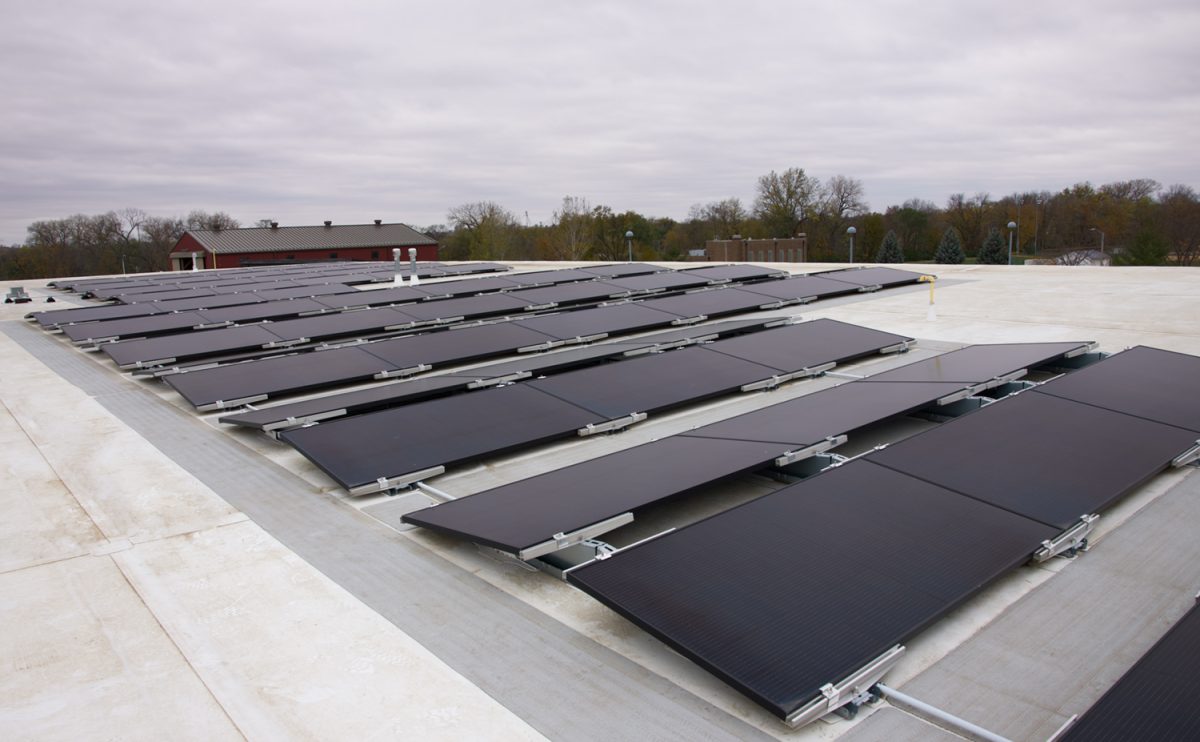A new solar array was added to the roof of the Iowa City Public Works Facility to create sustainable power for the city building. This array brings the city a step closer to meeting its climate goals, officials say.
The solar array fits into Iowa City’s Climate Action Plan. The plan was established in September 2018 and aims to reduce greenhouse gasses by 26-28 percent by 2025, and 80 percent by 2050.
The solar array contract amount is $127,492, and the Inflation Reduction Act will give a 30 percent credit back to the city, which would account for around $38,000.
Located at 3810 Napoleon Lane, the 99,294 square feet Public Works building houses departments essential for the city it needs to operate around the clock. These departments include engineering, street and traffic engineering, and resource management.
Special Projects Administrator Shaun Bradbury said the array consists of 100 solar panels with a peak power production capacity of 40 kilowatts which is enough to sustain all power needs of the facility. A kilowatt equates to 1,000 watts, in comparison, a house consumes roughly 29 kilowatts a day.
While the array may look small compared to the roof of the Public Works Building, the array can account for all the energy needs of the facility because the facility was built with energy efficiency in mind, Gardner said.
The building has 40 skylights which reduce the need for lighting power. The building also has polycarbonate walls, LED lighting, and a variable refrigerant flow cooling system all contributing to a reduced power demand.
The city expects the solar array to last between 20 to 25 years, possibly longer. Climate Action Coordinator for Iowa City Sarah Gardner said the solar industry is maturing and because solar panels have not been around for an extended period the panels may last over 25 years.
“We are starting to see solar panels for these older systems lasting longer than that 20 or 25 years, so we know 20 years for sure,” Gardner said. “Beyond that could be more; we’ll have to find out.”
Iowa City Climate Action Analyst Daniel Bissell said the longevity of the solar panels makes the investment economical for the city.
“The beauty of a solar array is that it’ll continue to generate energy 25, 30, perhaps even more years into the future,” Bissell said. “The initial impact of the manufacturing and shipping of those materials will be offset fairly quickly and continue to reduce our environmental impact as a whole.”
A vital element that went into making the project possible is the federal Inflation Reduction Act, or IRA. The IRA was passed at the federal level in 2022 and gives federal tax credits, which reduces the overall cost of this project by an estimated $38,000.
The IRA gives back tax money for solar projects through the IRA. Since the city is a government entity it receives federal subsidies for the amount that would have qualified for tax credits.
Gardner said the impact of this act helps make the investment in solar power more economical. This also applies to private entities looking to move to solar power. She also said the city helps people interested in solar power navigate benefits that are available like the Inflation Reduction Act.
“This is a new innovation on the federal level that’s created a pathway for us to get those credits as a way of helping subsidize investments like this,” Gardner said. “It’s great.”
RELATED: UI requests regent approval for campus renovations totaling over $100 million
Gardner said any new building the city builds is now going to have sustainability in mind, allowing for solar panels to be integrated into the design even if they are not installed when a building is first built.
The next project the city is looking to add solar power to is the Iowa City Municipal Airport. Gardner said they are exploring different design options for that location and solar power should be installed in 2024.
Additionally, the city has been working on a new Transit Operations and Maintenance Facility. The new facility is designed to pursue a sustainable fleet for the 1.5 million annual transit riders. This facility will be designed to incorporate solar panels.



